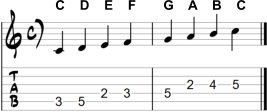
home \ courses \ music theory \ page 1
Music Theory
Some people love it, some people hate it. What ever your feelings are about music theory: it is essential! By getting a better understanding of music theory, you'll get a deeper understanding of your instrument, which translates in making better music, and - just as important - it will make you enjoy playing more. In my experience, people that start to know the basics of music theory also start to like it. So let's take the challenge and dive into music theory!
Tones
When playing an instrument, you use that instrument to produce tones. Tones are sound with a certain pitch and a certain length. When there is no clear pitch or length, the sound is called noise. When listening to music, you’ll discover that there is a set of tones that is used over and over again, in thousands of different combinations. Let’s investigate those tones!
Tones are named with a letter, from A to G. Some tones get an extra addition: a (b) or a sharp (#). First, we’ll look at tones without such extra’s: the root tones.
In modern music theory we have become accustomed to starting a list of notes at C. After G you go back to A:

After B you have the C again, and from there you can continue:

The distance between two notes with the same letter is called an octave. "Octave" comes from the Greek word “octa” and that stands for the number eight. An octave is the 8th note. If you start counting at C then C is 1, D is 2, E3, F4, G5, A6, B7, and the next C is 8.
From the first C to the second C is an octave, but also from the second to the third C is an octave. If you go from the first to the third C, you cover two octaves (it's called a double octave). Also from the first D to the second D is an octave. from the first E to the second E is an octave, etc.

So the same notes repeat. The different notes with the same name sound the same, but there is still a difference in pitch. Compare this with a man and a woman who sing the same melody together. They sing the same, yet one voice is higher than the other. An interesting fact is that anthropologists have done research on the experience of an octave. The conclusion was that all people from the various cultures studied can recognize the octave, no matter where they lived or how they were raised.
Let's play this series of root notes on the guitar. This series of notes is called “the scale of C major”. Take this for granted for now, we will go into that name in more detail later.
If you do not know how to play these "guitar tabs", please follow the tutorial
"Reading Guitar Tabs Basics"

<<< Start | Next page >>>